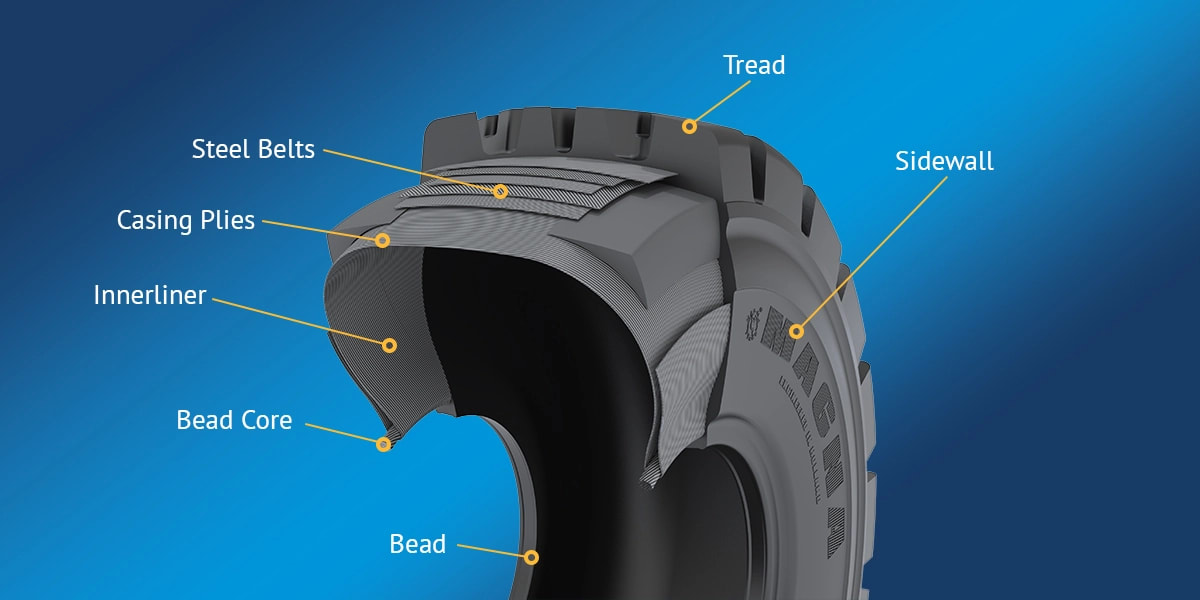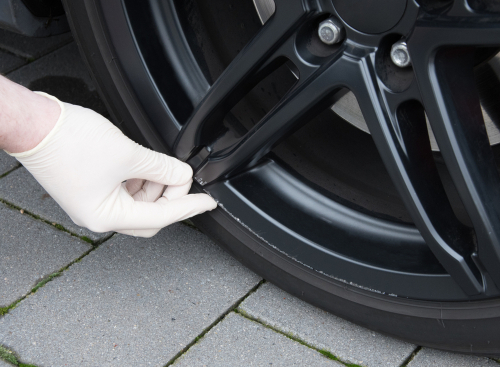Tire News & Information
Free shipping
Best price guarantee
Special pricing
Financing with Resolve
Easy returns

Tires are the unsung heroes of the automotive world, quietly supporting the weight of our vehicles and ensuring a safe, comfortable ride. While often overlooked, these complex structures are engineered to withstand the demands of daily driving, providing traction, stability, and durability.
To truly appreciate the importance of tires, it's essential to understand their anatomy—the various components that work together to create a tire that performs optimally in a wide range of conditions. By delving into the intricacies of tire construction, we can make more informed decisions when it comes to maintaining and replacing these critical safety features.
In this article, we'll take a closer look at the key components that make up a tire, exploring how each part contributes to the overall performance and longevity of this essential piece of automotive equipment. From the tread that grips the road to the inner liner that holds the air, we'll break down the anatomy of a tire and discover why understanding its structure is crucial for every vehicle owner.
What is a Tire Made Of?
Tires are complex structures made up of various components, each serving a specific purpose. The main components of a tire include:
Tread
The tread is the outermost layer of the tire that makes direct contact with the road surface. It is designed to provide traction, grip, and durability in a variety of weather conditions.
Sidewall
The sidewall is the rubber component that covers the area between the tread and the bead. Its primary functions are to resist pressure, provide stability, and protect the inner components of the tire from damage.
Body Ply
Body plies are layers of fabric, often made of materials like polyester or rayon, that run perpendicular to the tire's tread. They give the tire its strength and flexibility, allowing it to withstand the stresses of the road.
Belt Plies
Located directly beneath the tread, belt plies are typically made of strong materials like steel or polyester. They provide stiffness and stability to the tread area, enhancing the tire's durability and performance.
Beads
Beads are the inner edges of the tire that sit firmly against the wheel rim. They create an airtight seal, ensuring the tire remains inflated at the proper pressure.
Inner Liner
The inner liner is an impermeable layer inside the tire that helps keep air inside. It acts as a built-in tube, designed to prevent slow leaks and maintain consistent tire pressure.
These components work together to provide a safe, comfortable, and efficient ride. Each part plays a crucial role in the tire's overall performance, from providing traction and stability to protecting against punctures and blowouts. By understanding the materials and functions of these components, drivers can make more informed decisions when it comes to tire maintenance and replacement—ensuring a smoother, safer journey on the road.
Tread: Where the Rubber Meets the Road
The tread acts as the crucial junction between your vehicle and the pavement, influencing how your car handles and maintains contact with the surface. Tread patterns are crafted with precision to meet various driving requirements, ensuring confidence whether navigating through wet streets or on dry roads. These patterns are designed to channel water efficiently, minimizing the risk of hydroplaning and maintaining control.
Each type of tread pattern serves a distinct purpose. All-season tires feature a versatile design suitable for year-round use; winter tires come with deep grooves and numerous sipes for enhanced traction on snow and ice. Performance tires have larger blocks to maximize contact and improve handling at higher speeds. This diversity in design caters to different driving conditions and styles, allowing for optimized performance across various environments.
Keeping an eye on tread depth is vital for ensuring safety and efficiency. As tread wears down, its ability to move water away diminishes, which can lengthen braking distances and increase the risk of skidding. Simple tools like a tread depth gauge or the penny test can help assess whether your tires are still within safe limits. Once the tread reaches 2/32 of an inch, replacing your tires becomes necessary. This vigilance not only prolongs the lifespan of your tires but also ensures a safer driving experience.
Sidewall: The Tire's Protective Shield
The sidewall acts as a sturdy barrier surrounding your tire, connecting the tread to the bead. It is engineered to withstand the forces encountered during daily drives, deflecting impacts from uneven surfaces like potholes and curbs while preserving the tire's shape. This design ensures the tire can endure pressure from both the vehicle's weight and the road, enhancing overall ride comfort and vehicle stability.
In addition to its protective role, the sidewall is a detailed information hub. It features essential tire details such as dimensions, load index, and speed capabilities, all of which are critical for ensuring compatibility with your vehicle. These markings also include the tire's production date, aiding in assessing its age and readiness for use. Familiarity with this information helps in the selection of tires that align with your driving requirements and vehicle specifications.
A robust sidewall does more than just protect—it plays a pivotal role in tire performance. It prevents the tire from deforming under heavy loads, which is key to maintaining optimal contact with the road surface. This stability is crucial for effective handling, particularly during sharp turns and sudden maneuvers, underscoring the sidewall's importance in both safety and driving dynamics.
Belt Plies: The Tire's Backbone
Belt plies serve as the tire's internal reinforcement, providing essential support that bolsters performance and longevity. Positioned directly beneath the tread, these layers are crafted from resilient materials such as steel or polyester. Their construction ensures the tire remains firm and responsive, especially when navigating challenging driving conditions.
The durability of belt plies is key to maximizing tread life. By promoting an even distribution of pressure across the tread surface, they help prevent irregular wear patterns that can shorten a tire's lifespan. This consistent pressure distribution not only enhances the tire's durability but also contributes to a smoother driving experience with improved handling characteristics. The robust design of belt plies helps maintain the tire's shape, which is crucial for stability during high-speed travel, reducing the likelihood of performance issues.
Belt plies also play a protective role by acting as a barrier against sharp objects that could puncture the tire. This layer is vital for maintaining tire integrity, especially when traveling at high speeds where safety is paramount. The added protection from belt plies ensures that the tires are equipped to handle everyday road hazards, offering peace of mind and reliable performance.
Body Ply: Strength and Flexibility
Body plies serve as the tire's core framework, designed to handle the rigors of driving by providing essential support and flexibility. Constructed from durable fabric cords, these plies are layered in a crisscross pattern beneath the tread. This strategic arrangement ensures the tire can adjust to various road conditions while maintaining its structural integrity.
Bonded with rubber, the body plies contribute to a cohesive tire assembly, effectively sealing in air to preserve optimal tire pressure. This airtight design is critical for not only maintaining efficient fuel consumption but also enhancing vehicle control. The rubber coating safeguards the plies from environmental factors, extending their lifespan and performance reliability.
The versatility of body plies becomes apparent as they absorb shocks from road imperfections, protecting the tire from potential damage. Their ability to flex and adapt allows them to cushion the vehicle over bumps and uneven surfaces, enhancing ride comfort without compromising durability. This adaptability is key to ensuring a steady, controlled driving experience, highlighting the indispensable role of body plies in tire design.
Beads: Keeping the Tire Firmly in Place

Beads ensure a tire's secure fit onto the wheel rim, acting as the foundation for maintaining proper inflation. These inner edges boast a core of tightly wound steel wire, enveloped in rubber, to provide a lasting grip that keeps the tire secure under various conditions. This design is crucial for preserving the tire's form and functionality, allowing it to withstand the demands of driving with unwavering stability.
Maintaining consistent tire pressure is critical for safety and efficiency, and properly seated beads play a major role in achieving this. The strong union between the tire and rim prevents air leakage, which is vital for optimal handling and fuel economy. This secure connection becomes especially important when traveling over uneven surfaces or during sharp turns, where stability is essential for maintaining vehicle control.
Proper seating of beads prevents gradual air loss and sudden deflations, both of which can pose significant safety risks. Ensuring that beads are correctly installed and inspecting them routinely for any signs of damage can help avert potential issues, keeping the tire securely in place and performing at its best.
Inner Liner: The Tire's Built-In Tube
The inner liner plays a pivotal role within the tire's architecture, acting as a barrier that retains air pressure effectively. This specialized layer, crafted from advanced rubber compounds, ensures an impermeable seal that prevents air from escaping. By maintaining the tire's inflation, it underpins the tire's ability to perform reliably under various driving conditions.
Designed to endure the rigors of daily use, the inner liner maintains its integrity against the subtle forces that seek to diminish tire pressure over time. Its robust construction not only prevents gradual air loss but also contributes to the tire's resilience against external factors. This enduring protection helps the tire maintain its shape, crucial for sustaining the vehicle's stability and fuel efficiency.
Consistent inflation, secured by the inner liner, is vital for precise vehicle handling and optimal tread contact with the road. This stability ensures that the tire delivers dependable performance, enhancing safety during sudden maneuvers. By supporting even tread wear and prolonging tire life, the inner liner plays an essential role in maximizing both the tire's effectiveness and the driver's peace of mind.
Putting It All Together for Safety
An in-depth knowledge of tire anatomy is a key tool for drivers in ensuring their vehicles perform safely and efficiently. Regular tire checks should be a priority—examine your tires for any signs of irregular wear, damage, or issues with tread patterns that could affect grip and safety. Detecting these signs early can avert more extensive problems, safeguarding both your tires and vehicle.
Vital maintenance practices include keeping tires properly inflated, rotating them as recommended, and maintaining correct alignment. Correct inflation helps distribute wear evenly and supports optimal fuel efficiency. Regular tire rotation helps balance wear across the set, prolonging their service life. Ensuring your vehicle's alignment is correct keeps tires in the best position for effective road contact, crucial for handling and extending their lifespan.
Choosing suitable replacement tires is crucial to vehicle safety and performance. Engage with experts when selecting new tires to ensure they meet your driving conditions and vehicle needs. Tire professionals can help identify the right tires that align with your specifications, enhancing both safety and driving experience. This detailed attention to tire selection and care ensures your vehicle remains safe and dependable, ready for every journey ahead.
Understanding the anatomy of a tire is essential for making informed decisions about your vehicle's safety and performance. At SimpleTire, we are committed to providing you with the knowledge and resources needed to keep your tires in top condition. Shop for tires online with us and find the best deals on high-quality tires that meet your specific needs.
Ready to find the perfect tires?
Search By